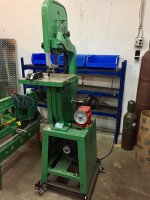There is yet another way, which is to use a DC motor, speed controller and power supply. Common source for these is a treadmill, but if you use all the parts from a treadmill, then you have to modify the controller board so that it doesn't insist on starting at zero speed.
Here is one version of this:
Drill Press - Treadmill motor conversion - The Garage Journal Board
Another:
Use a Treadmill DC Drive Motor and PWM Speed Controller for Powering Tools - All
I added a jackshaft to an old benchtop Delta, I swapped a plate and pillow blocks (sorta, I made my own out of aluminum plate and flanged bushings) in place of the motor, and hung the motor on the plate, off to the side. The old motor 4-step pulley was put on the shaft and a new 3-step one was put on the motor. The motor drives the largest step on the shaft pulley. I got fancy, I jammed a piece of angle under the motor mounting plate so I could push on it with a bolt to tension the belt to the jackshaft. Since I could no longer reach the switch on the motor, I added a handy box with a power outlet and two switches, and a floodlight socket pointed at the work surface. I used to have pictures I could link to, but those died when comcast stopped supporting personal web pages. I can take some more, just not right now.
As far as speeds go, I never used it on anything but its slowest speed from then on. I never missed the faster speeds even with tiny drill bits. I'm not running a machine shop by the hour, I don't need theoretical best productivity.
I replaced it with a floor model import with a deeper throat that could also run MT bits if I had to (only needed it a couple times so far)...it functionally has the same jackshaft setup from the factory, except it is on a pivoting shaft between the motor and spindle. And I still leave it on the lowest speed.






